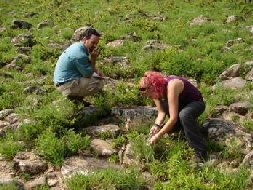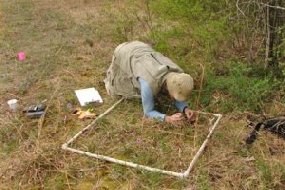MBG, Conservation Biologist, Restoration Ecologist, and Global Change Biologist
Research Interests
• Conservation Biology
• Global Change
• Restoration Ecology
• Demography and population ecology of rare plants
• Ex situ conservation and autecology of endangered species in the Midwest
Web page: Matthew Albrecht, Quinn Long, Adam Smith, Species Conservation
Project title: Effects of global climate change on rare plants. A major challenge for conservation biologists is predicting the fates of species in a rapidly changing climate of the 21st century. In the southeastern United States, rock outcrops support a distinctive flora that includes rare endemic plants, many of which are of conservation concern due to their restricted distributions and habitat destruction. Understanding the future fates of rare edaphic endemics is especially challenging because it’s unclear whether current distributions are limited by the specialized soils of outcrops, by climate, or by a combination of climate and soil. In this study, we ask two questions: 1) Can edaphic endemics live outside of their current climate niche? 2) What is the relative importance of soil and climate in restricting the distribution of edaphic endemics? To answer these questions, the student will conduct seed transplant experiments with species in the genus Leavenworthia, which are being used a model organisms to understand the role of climate and soil in structuring geographic distributions of rare edaphic endemics. The student will establish seed germination and seedling experiments in germination incubators set to current and future climate scenarios. Each week, the student will record demographic data (germination, survival, and plant morphometrics) for seeds and seedlings, maintain experimental conditions, and enter demographic data into a Microsoft Excel database. Additionally, the student may participate in measuring the microclimate of glades to better understand the environmental conditions these plants experience. Students can participate in the analysis and preparation of manuscripts based on the experimental data.
Selected Publications
• Albrecht, M.A. and J.M. Maschinsky. 2012. Influence of founder population size, propagule stages, and life history on the survival of reintroduced plant populations. Reintroduction in a changing climate Promise and, Perils. J. Maschinski and K. E. Haskins (editors). Island Press, Washington, DC.
• Albrecht, M.A., E.O Guerrant Jr., J.M. Maschinsky and K.L. Kennedy. 2011. Editorial: A long-term view of rare plant reintroduction. Biological Conservation 144: 2557-2558.
• Albrecht, M.A. and K.A. McCue. 2010. Changes in demographic processes over long time scales reveal the challenges of restoring an endangered plant. Restoration Ecology 18: 235-243.
• Smith, A.B., M.J. Santos, M. S. Koo, K.C. Rowe, K.M.C. Rowe, J.L. Patton, S. Beissinger, and C. Moritz. 2013. Evaluation of species distribution models by resampling of sites surveyed a century ago by Joseph Grinnell. Ecography 36:1017-1031.
• Smith, A.B. 2013. On evaluating species distribution models with random background sites in place of absences when test presences disproportionately sample suitable habitat. Diversity and Distributions 19:867-872.
• Smith, A.B. 2013. The relative influence of temperature, moisture, and their interaction on range limits of mammals over the past century. Global Ecology and Biogeography 22:334-343.
 |
 |